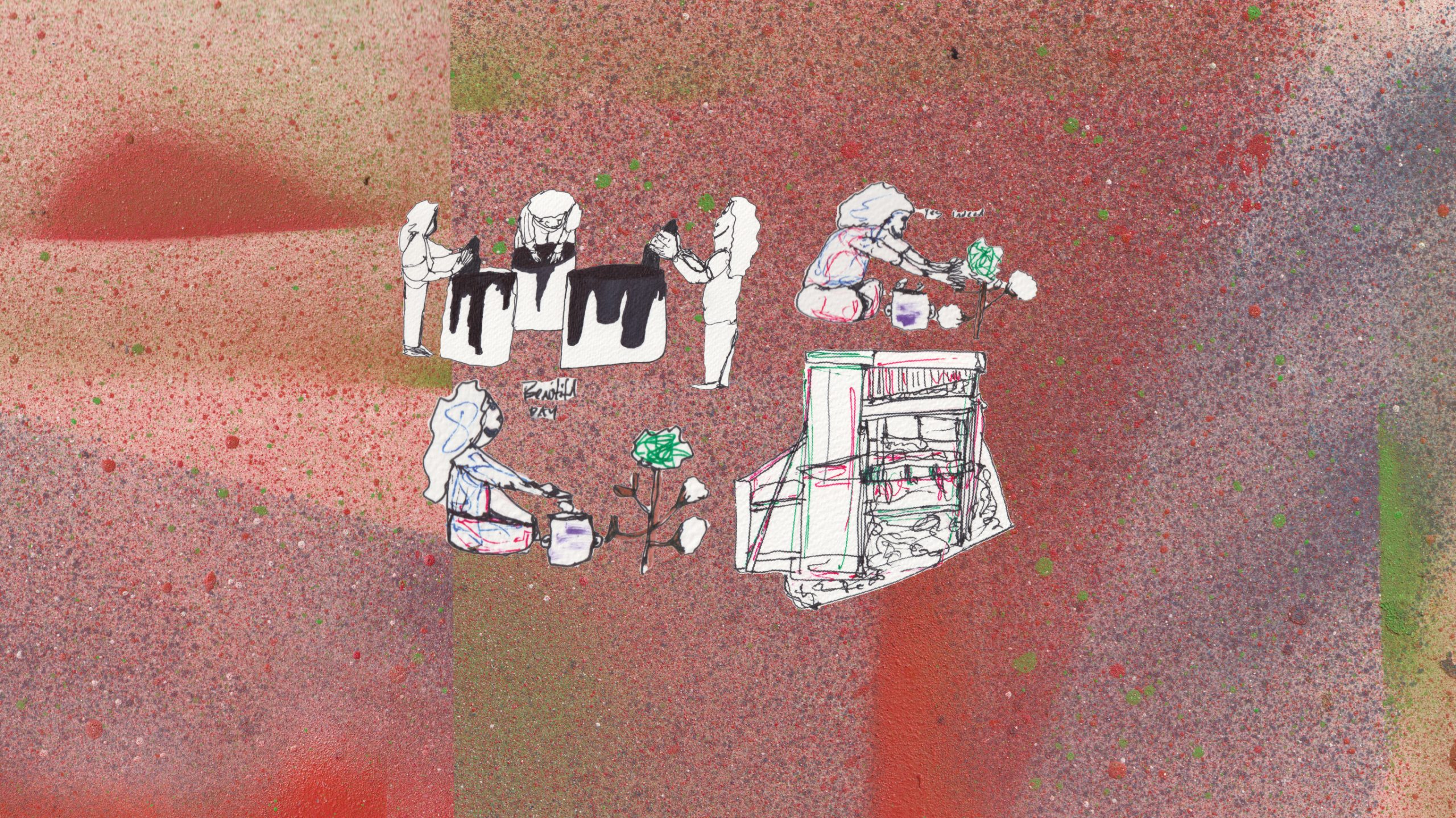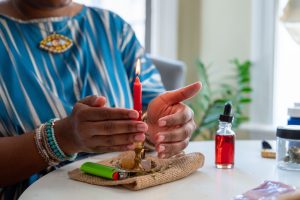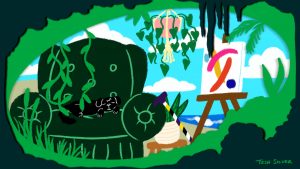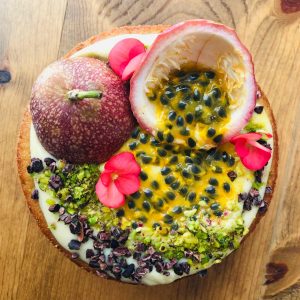Featured image: An illustration with a peach-purple background with an effect that looks like air-brushed paint. Several black and white illustrations showing people making textile art are in the middle of the composition. Illustration by Kaleem Jones.
In March of last 2020, as lockdown orders went into place, there was much collective confusion, complaining, and panic. Folks were upset about not being able to be in spaces centered around socializing, entertainment, or arts/culture/leisure. For many disabled folks, there was less panic around needing to stay home — we are used to this in fact. There was, however, much disabled frustration stemming from the fact that non-disabled folks refused to stay home, refused to think about collective wellness, and refused to unpack their ableist expectations of living in this world. For those of us with disabilities who are fortunate enough to have a place to call home, home is often our sanctuary, if not the only place that feels safe and accessible to us. I often talk to my disabled friends about what our disabled sanctuaries look like, both in reality and in our wildest fantasies. In this interview, which is the second in a series in which I get to chat with disabled artist friends, I had the pleasure of talking to Sangi Ravichandran, a dear friend who lives and breathes creativity into all of her work. I’ve been so grateful for and nourished by all of her many offerings; her homemade food, tea blends, customized abolitionist jewelry, and tinctures have all been blessings to my own disabled home sanctuary. You can see her art on instagram @SaltyBrownFemme. What an intimate pleasure it was to have this chat.
* * *
carrie sarah kaufman: What would you like to share about yourself as a human and creative?
Sangi Ravichandran: The first thing that comes to mind about myself as a human is that I’m persistent. I am a persistent person and driven in a tunnel-visioned manner sometimes. I see the world and imagine values and ideas in a very visual way. Feelings come to me as images, too. I cannot separate my human existence from my creativity. My brain always goes faster than words, and the rest of my body sometimes struggles to meet my creativity with my existence, but my creative brain always seems ahead. This has allowed me to imagine a whole lot faster than some of the world around me because I can think in abstract ways really quickly. This is what led me to abolition as a way of life early on.
I am also a body that constantly struggles. I struggle and suffocate much of the time to meet myself where my brain and the world wants me to. I also live and feel a lot of other people’s suffering — especially loss, grief, and death — in really powerful ways. This makes me want to isolate myself a lot because it becomes unbearable to carry the pain of someone who I have hardly met and their loss and grief. I hold it in my body and it feels like physical pain. I cry for days, unable to stop sometimes, and I often have no clue why. When I do understand why, I lament about someone’s pain and my heart and chest feels like it will burst for days on end. It has been such an interesting journey to figure out what to do with this. I am trying to learn about how all of me can be a tool for resistance.
I am also a very curious human. I want to know all the things there is to know. I want to read everything there is to read that aligns with my values. My desire is bigger than my body and one lifetime. I struggle with this, too. I vision and envision ten lifetimes in one moment. It is pretty wild. I feel like I am always on some drugs.
I am learning and unlearning all the time. I am always on a quest to fix myself, but my spiritual journey has been about resisting this and just allowing it to be. In my spiritual human journey, I believe that all suffering is preparing me for my death and I try to just absorb it as such. In that letting go, I find peace and solace.
My humanness is intertwined with pain and death so much.
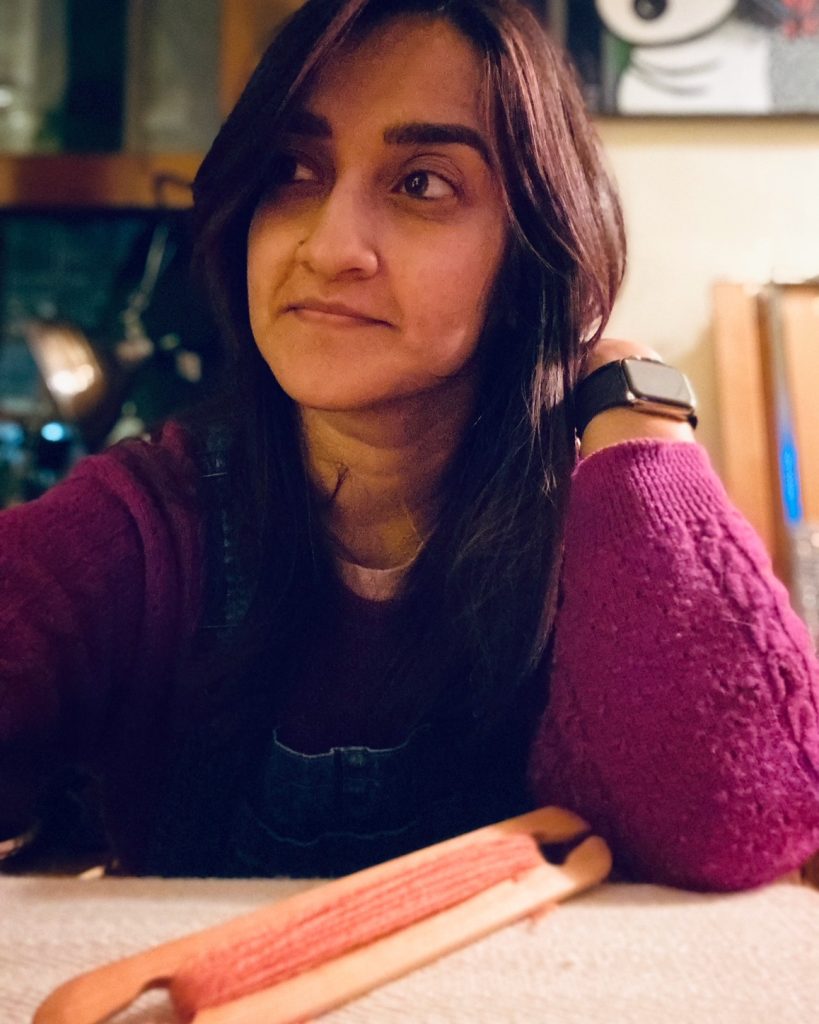
csk: Thank you so much for sharing all of this. I have been thinking about pain and death so much lately. It all feels so much closer than ever, and yet it’s always been deeply intertwined with our humanity, like you said. It feels like part of the collective/societal disconnect right now is the fact that we as a society don’t acknowledge or think about pain, sickness, and death nearly enough. I wonder if you can describe how your relationship with pain and death supports your particular humanness?
SR: This is a good question. I am not sure I know an answer to this yet. I do think I am working on figuring this out. I am always looking for my role in the world and healing intergenerational trauma cycles. I am thinking that perhaps this is where the answer is. I also met some Native leaders in September and saw so much through my conversation with them about pain and death and resistance. I think there are answers for me here, too. I am not sure what they are exactly yet. I do think that allowing this kind of relationship to pain and death will allow for personal and communal answers to evolve. My path has been to figure out how to make space for this kind of pain and death.
I am also trying to reorient my relationship to pain. It has been a really hard journey. Pain isn’t bad, it just is what it is. I think about this often. I am trying to notice my existence without putting values on it. This has been hard work — not sure I fully know how to do it yet.
I have also been thinking about pain as a preparation for death and letting go — death and loss and grief as preparation for death. This has also allowed me to understand attachments in a different way.
So much to learn…..
csk: Drawing inspiration from a meeting check-in question of yours, I wanted to ask you what is bringing you joy or light these days?
SR: In this moment, joy has been hard but I will try to answer this as generally as I can. Making art has been the light in my life lately. I have recently taken to dyeing and weaving. Something about slow making is so antithetical to the way my brain functions. It feels like a welcomed challenge — something I must do in order for me to live closer to my values. So weaving has helped me let go of control over time, over product, over immediate gratification (although every line I weave gives me gratification and joy). Just sitting there, feeling every inch of the fiber and making it into something beautiful reminds me of what is important about life and living. It reminds me that the human condition is far away from the way we have chosen to exist and in those moments of beauty and slow creation, I can find it again. It reminds me of the earth and soil and plants and animals and how much more evolved they are than humans (like [Robin Wall Kimmerer] says in Braiding Sweetgrass). It reminds me that I am all but a small speck in this vast universe of abundance. It reminds me of the ways I would like to live, of the struggles of people who create and are valued so little, of the earth that keeps on giving and teaching me — new things and life-giving things.
csk: Braiding Sweetgrass is so amazing, I have learned and appreciated so much from it! And speaking of braiding, I love the image of you weaving lines of patience and gratitude together within your fiber creations. Can you tell me about your favorite colors to work with?
SR: I LOVE this question. Colors have informed me for a long time. Spaces, seasons, and presence informs colors that I gravitate towards. I have been naturally dyeing and then weaving. Lately, I have been drawn to a rust color that sort of feels like the color of the earth. I think this is because I crave home (India) and I feel so far from it now. I don’t have a safe way to go there and it has been three years since I saw my family. It is wearing on me and I think this earth color symbolizes home and the soil where I grew up — its smell and warmth and lightness. I am also slowly feeling drawn to make a teal, which is hard to make with natural dyes. It feels like a challenge that I am drawn towards; to make this color and weave with it. I am not sure why, but I am moving towards teal and I hope I find answers when I start finding the color.
csk: What are your crafts? What have you been focusing on the most, lately?
SR: I have never been able to stick to one thing. This is my neurodiverse brain. But when there is so much in the world to learn, the idea of sticking to one thing feels like it is based on deficit thinking.
Lately, I have gone back to fibers. I have had this dream of a soil-to-garment practice for a long time. I come from cotton and silk in India. My dad worked in spinning mills and I knew cotton like it was my skin. Silk was also available and revered so much in my life. I am going back to them. I saw my mother dress so fashionably in handwoven garments all my life. She was my fashion icon — I say that my mother is a woman of colors. I am going back to all of these tactile memories and what I am made of. I have been dyeing and weaving lately and it has been life giving. Learning about natural dyes is its own spiritual journey. On top of that, I have been using those fibers to weave cloth.
I ultimately want to grow cotton, grow my own dyes, spin, dye, and weave cloth so I can print and sew garments for myself and my community, but I am not there yet in terms of skills. Perhaps I am half way there. So I want to practice every day and learn new things, face challenges that cloth has for me, and learn about life, living, joy, abundance, and be in a self-sufficient garment community with my queer people and opt out of capitalism — someday. I am moving towards this.
csk: May it be so! I definitely see you working towards this ultimate goal of growing everything that you use. Another color question — what are some of the colors that you think of when you think of your mother, the “woman of colors”?
SR: My mother was always a sort of creamish orange, a peachish color for me. She is sometimes just a dark burgundy, but most of the time she is a warm peachish color.
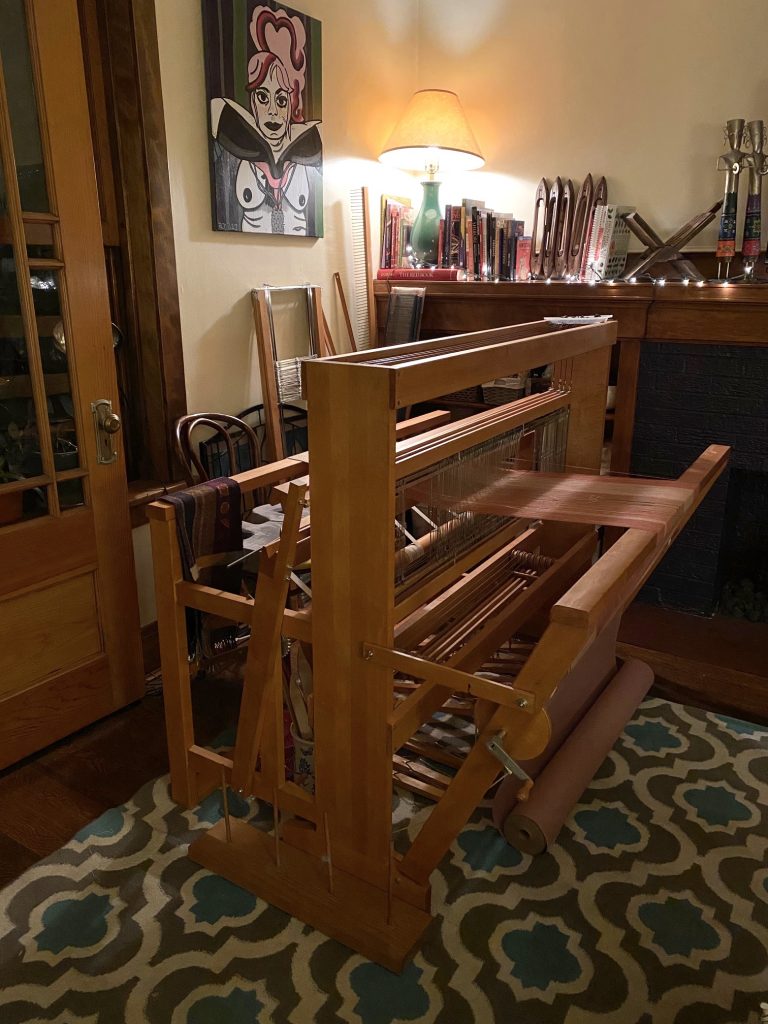
csk: What are the ideal conditions for you, for when you want to create art and magic?
SR: I wake up everyday wanting to create (when I am not depressed or heartbroken). Most days I wake up wanting to create. This drives me. Unfortunately I have other work, but I am learning to see most of my work and art as extensions of my liberation work and values. This allows me to move into whatever my day has for me, guilt free. It is hard sometimes because my neurodivergent brain has a hard time with inertia. Like, if I am weaving, I want to do it for days and weeks. It is hard to switch. So apart from transition issues, guilt, and depression, the magic to create is within me. It is literally the first thing I wake up thinking about.
csk: Do you have a place that you would call your disabled sanctuary? Can you describe it?
SR: Being disabled has been a very isolated journey for me for most of my life. Because I am rather privileged and have always been high functioning, my disabilities have been met with a lot of resistance, denial, and non-acceptance from my people. It has taken me many, many decades to finally see myself for what I am and what my needs are. In typical virgo fashion, I was extremely critical of myself and super toxic to myself, too. My crip community has helped me see me and understand my needs and be ok with fulfilling my own needs.
It has taken me a lot of time to think about and create this for myself but most of my home is my disabled sanctuary, to be honest. I say most because I have thoughtfully organized my space for my body’s sake. I cannot exist in spaces that are cluttered or not aesthetically pleasing. It gives me heart palpitations. I have a lot of neurodivergent obsessive tendencies. Colors are really important to me. My creative spaces have enough tables, coasters, body rollers, seats and leg rests that help reduce pain. My writing space has plants, standing desks, light and things organized for my mental and physical well being. I live with someone who is more cluttered than I am and my dog who sheds a lot of fur. This increases anxiety for me and my allergies, and then body related issues and chronic pain follow. But I have sanctuaries within my home where I can go off to and exist in ways that my body needs. It has been hard to learn how to co-exist with beings so different from me within a home, to have my needs fulfilled while also allowing others to exist.
Additionally, sometimes Instagram has been my sanctuary where other crips share themselves, and allows me to just be. People see me and I see myself through other crips I am connected to. This is a safe space for me.
Despite all this, on days when I am depressed, a corner of my bed is my sanctuary with my dog right next to me.
csk: Do you have any favorite home ritual practices that you can share with us?
SR: I live very ritualistically. I have this ritual of getting water, tea, and one more drink before I begin adulting for the day. I have three coasters in every room so each of these can have a station. It grounds me to no end. I also love walking my dog in the morning. Her joy in seeing the earth and nature gives me so much joy — no matter how cold it gets. While it increases pain for me, the joy from that ritual of greeting the world and earth with her is unparalleled.
csk: What are some of the other living beings and/or spirits that support you in your creation of space and art?
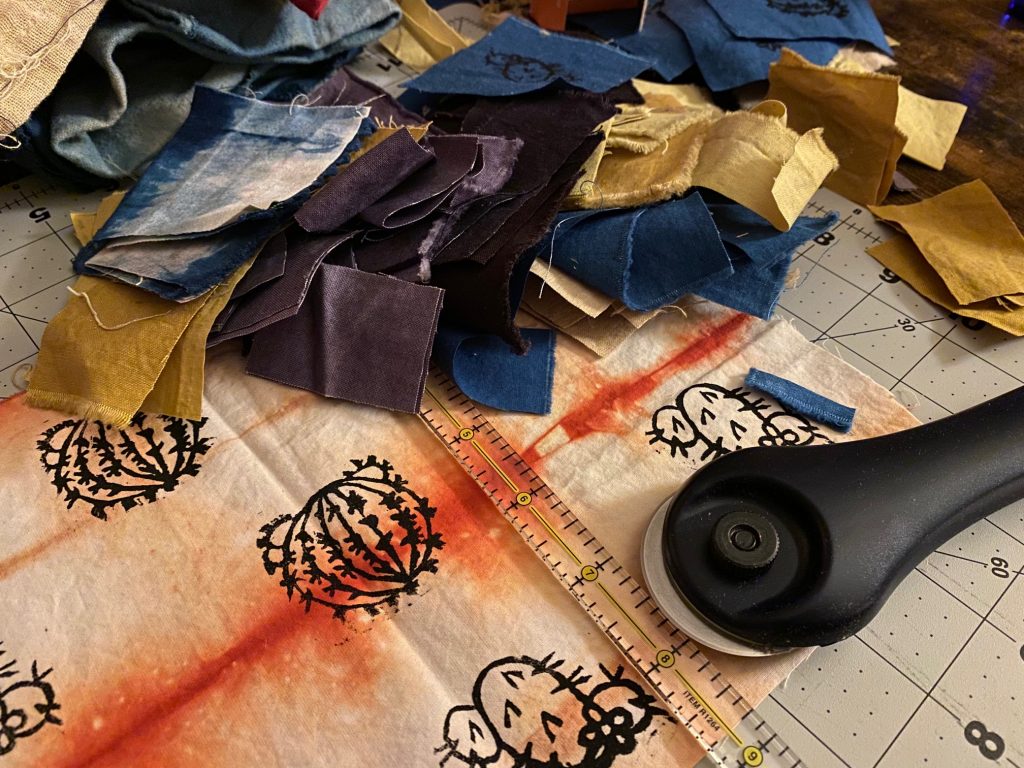
SR: Many of my ancestors, my granddad, my dad and mom — all in different ways. They guide my persistence, curiosity, and thirst for healing. My granddad is a healer just by existence, even though he wouldn’t ever take that title. His ways inform what I should put out in the world and how they can all act as objects towards healing myself and others. We are all so wounded and are suffering. [My family’s] energies help me think about how I can make this easier and supportive for others around me.
csk: How was your experience navigating lockdown, as an artist and business owner?
SR: I felt like I could finally stop when the lockdown happened. I was finally able to exist and create and have space for being an artist. It was so weird. I am not sure how I feel about saying ‘silver lining’ here, but as a crip artist, the lockdown allowed space for me to stop running and instead think about nourishing things through creating. It was quite lovely.
My business exists in that I want to find ways to support myself and the orgs that I love so much. Truly — otherwise I would just create to create and give [things] away — this is really what I want in the future. It is hard to answer the question about business because I dislike it so much. I dislike money and my forced relationship to it. During lockdown, things were pretty decent as a small business owner, though. Maybe because people were spending less on random shit or maybe because they couldn’t buy things at shops…I am not sure, but it was a better time for online business in that I was able to make things, sell them, and support myself while giving away a bunch of money.
csk: What disabled femme wisdom do you have to offer, as we navigate an ongoing pandemic and a forever changed and ever-shifting society?
SR: I want us to realize that things have changed and are changing. Overnight, what we understood to be care shifted to risk. I want us to see this. Because once we see it — accept it — we can make beautiful things happen. We have always known how to navigate risk — thanks to crip wisdom and creativity. We can do it now, too. We need to just see it and accept it and grieve whatever gross shit we were attached to so that we can make magic.
About the author: carrie sarah kaufman is a queer, multiply disabled, white, Jewish femme. she is a kitchen witch, a plant mama, an artist and survivor. cooking, ritual and poetry are her current tools for connection and healing. her work explores disabled embodiment, sexuality and intimacy as well as themes in Jewish magic and spirituality.
